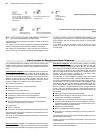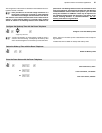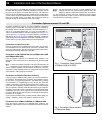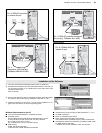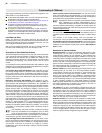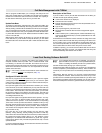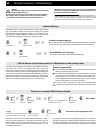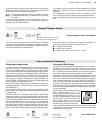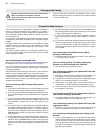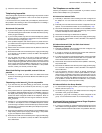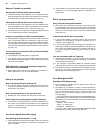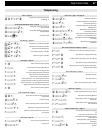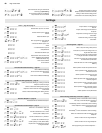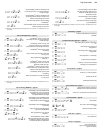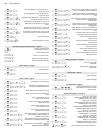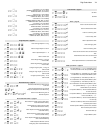
64 Cleaning of the Casing
Liquids entering into the case may cause a mortal electric
shock or a damage or destruction of the unit.
-When cleaning the case, make sure to prevent any liquid
from dripping into the case.
Protect the PBX against moisture, dirt, aggressive fluids or steam.
Should a cleaning be necessary, wipe the case with a slight humid cloth
or use an antistatic fabric.
The functional richness of the PBX makes it sometimes possible that a
function is started unintentionally and by mistake (e.g. by dialling a
wrong number sequence). It also is possible that you dialled an incor-
rect programming sequence and are starting a function that has an
unknown effect to you.
Or you have no knowledge about the authorizations and permissions of
the subscribers, which might be limited by the configuration program
COMset.
Sometimes problems that are suspected to be in the PBX are actually
problems located in the telephone (e.g. ringer switched off, no MSN
entered). There might also be problems with power failures or the
exchange lines.
The following chapters will assist you in finding minor problems your-
self. If you are still not finding a solution here, please contact your dealer
or the supervisor of the PBX.
You are hearing an unexpected Tone
Various tones in the receiver are signalling various operating modes of
the PBX (see chapter Listen to internal Dial Tones on page 38).
If you are in programming mode, you will hear e.g. the acknowledge-
ment tone as a signal for entering the correct password or the end of a
programming sequence.
The internal dial tone after picking up the receiver or after pressing the
FLASH- or R-key is signalling that you can start to dial a number.
If you hear a different tone than expected and described in the program-
ming description, most often a mistake in dialling or a missing authori-
zation or permission is the reason. The following chapters will describe
examples of these situations.
You are not hearing a Dial Tone after Picking up the
Receiver
ቢ If you only have this problem with some internal telephones, please
check the wiring and plugs. Please also check the telephone.
ባ If you only have this problems with single internal telephones, prob-
ably no internal telephone numbers were defined via configuration
program.
ቤ If you only have this problem with some internal telephones, these
might be configured as door phones with COMset. In this case, you
are immediately connected with the door after picking up the
receiver.
ብ If this problem exists for system telephones (COMfortel 1500/2500
and COMfort 1000/1200/2000 plus) and if „invalid MSN“ is shown in
the display when picking up the receiver, no or a wrong telephone
number has been configured as MSN in the telephone. Enter an
internal telephone number (from the range of numbers on the inter-
nal S
0
port) here.
ቦ If this problem exists for an internal ISDN telephone, perhaps no or
a wrong telephone number has been entered as the 1st MSN in the
telephone. Enter an internal telephone number (from the range of
numbers on the internal S
0
port). Please note that this MSN has to
presented to the PBX by the telephone (see manual of the tele-
phone).
ቧ Disconnect the telephone from the PBX for 5 seconds and an even-
tually existing external power supply (Pull the plug). If the problem
is solved, the telephone had a malfunction.
ቨ If you have this problem with all internal telephones, check the
power plug connection of the PBX or the possibility of a power fai-
lure.
ቩ If you have this problem with all internal telephones, disconnect the
PBX from the external power supply (Pull the plug) for 5 seconds. If
you hear the dial tone then, the PBX had a malfunction. If you are
still not hearing the dial tone, please contact your dealer or supervi-
sor of the PBX.
You are hearing the internal Dial Tone on a Direct
Exchange Line Telephone
ቢ The dialling method of the telephone is unknown to the PBX. Dial a
7 and put the receiver on hook.
Your are hearing the Busy Tone after picking up the
Receiver on a Direct Exchange Line Telephone
ቢ All available public exchange lines are busy.
You are hearing a pulsating Tone (Special Dial Tone) after
Picking up the Receiver
ቢ Eventually a subscriber Call Forwarding has been configured for
the telephone. You can switch this function off, if unwanted.
ባ Eventually a do-not-disturb service has been configured for the tel-
ephone. You can switch this function off, if unwanted.
ቤ Please check, if the filling status of the call data memory has
exceeded 80%. If possible, delete the call data memory entries.
ብ Check, if the type of dial tone has been modified and reconfigure
this modification, if unwanted.
You are hearing a pulsating Tone (Special Dial Tone) for 2
seconds after Picking up the Receiver
ቢ An automatic dialling has been configured for the telephone. You
can switch this function off, if unwanted (see p. 39).
You are hearing a pulsating Tone (Special Dial Tone) after
logging into a Group
ቢ Eventually a group Call Forwarding has been configured for the
group. You can switch off this function, if unwanted (see p. 55).
You are hearing a Clicking/Breaking after Picking up the
Receiver
ቢ If this is an analog telephone, the „call charge transmission imme-
diately“ has been activated with the configuration program COMset.
You will hear these charge unit pulses for the previous call after
picking up the receiver (particularly, if it was an expensive long dis-
tance call). If your telephone is not able to display charges, this con-
figuration may be obsolete.
Cleaning of the Casing
Frequent Problem Sources



